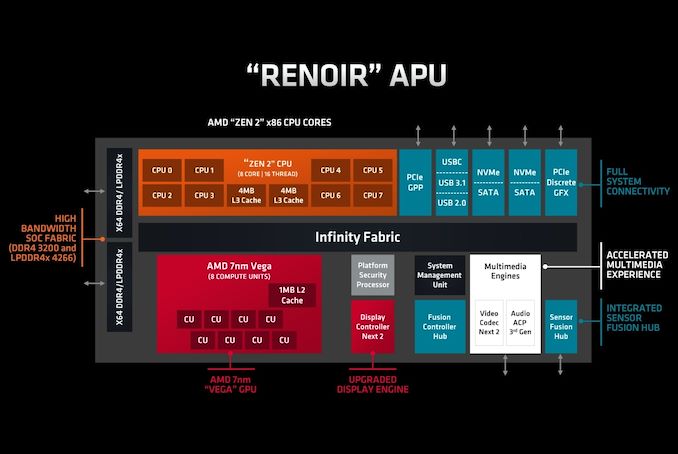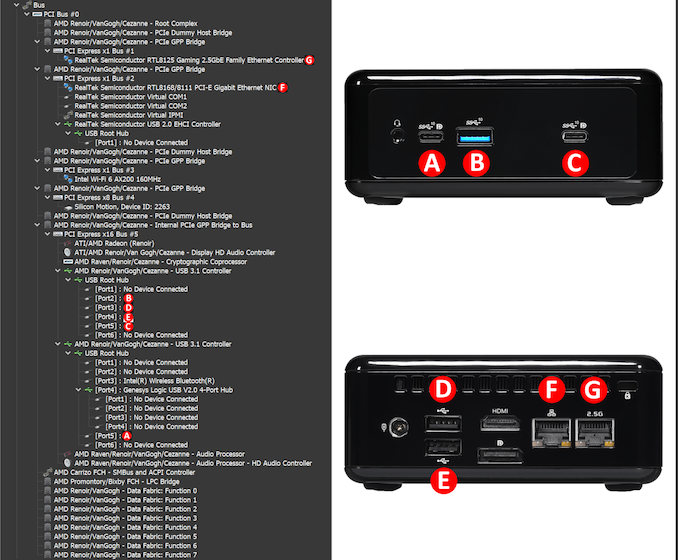ASRock Brings Zen 2 NUC : 4X4 BOX-4800U Renoir Mini-PC Reviewed
by Ganesh T S on November 25, 2020 11:00 AM ESTPlatform Analysis
AMD provided the press with a block diagram of the Renoir APU at the time of the launch of the Zen 2 APUs. These APUs are monolithic dies, and true SoCs with all I/Os being sourced from the APU without a platform controller hub in the picture.
The above layout needs to be studied in conjunction with the design of the 4X4 BOX-4800U's motherboard. The various I/Os of the system (as well as internal components) are enabled using the following configuration.
An idea of the distribution of the various PCIe lanes can be obtained from the above diagram:
- PCIe 3.0 x4 and a SATA port multiplexed behind the M.2 SSD slot (PCI Express x8 Bus #4)
- PCIe 3.0 x1 for the Intel Wi-Fi 6 AX200 160 MHz WLAN card (PCI Express x1 Bus #3)
- PCIe 3.0 x1 for the Realtek RTL8125 Gaming 2.5GbE Ethernet Controller (PCI Express x1 Bus #1)
- PCIe 3.0 x1 for the Realtek RTL8168/RTL8111 GbE Ethernet Controller (PCI Express x1 Bus #2)
Other aspects of interest include the distribution of various USB ports - particularly in terms of bandwidth sharing. For example, we expect ports 'B' and 'C' behind the same root hub to share bandwidth. Note that the PCI Express x16 Bus #5 includes the two USB 3.1 controllers as well as the integrated GPU. The two Type-C ports in the front panel also act as conduits for two display outputs from the latter.
In the remainder of this review, we will first look at BAPCo's SYSmark 25, followed by various UL benchmarks and miscellaneous workloads. We also present some gaming benchmarks. A detailed look at the HTPC credentials of the system is followed by testing of the power consumption and thermal solution.












53 Comments
View All Comments
hlovatt - Wednesday, November 25, 2020 - link
It would be great to see a comparison with new Mac Mini M1jgraham11 - Wednesday, November 25, 2020 - link
Ganesh why would you use a Bapco Benchmark - Mobilemark. Its results are complete crap. You must not know the history of Bapco and how its basically an arm of Intel, made for Intel chips.Notice how the AMD 4800U loses in every benchmark with Mobilemark and consumes more power doing it but when you look at the other results, synthetic or otherwise its mostly in AMDs favour... Intel benchmarking tools at work. This is a known thing among everyone who follows this stuff. If you want to maintain your credibility stick to independent benchmarks not ones made by the vendor for the vendors own chips.
brucethemoose - Wednesday, November 25, 2020 - link
I feel like the 35W 4800HS, with a bit more cooling, would be a better sweet spot for this form factor.Speaking of which, my 4900HS doesn't idle that hot. But I did notice that it behaves quite differently when running on battery (where it drops down to 400Mhz) and on AC (where it wont go below 1GHz, even though the cores are largely asleep). Its possible that this 4800U is stuck in the Windows "plugged in" profile.
TheinsanegamerN - Tuesday, December 1, 2020 - link
Given the box pulls 65 watt, there is no way it’s sticking to its TDP. A 4800hs would likely perform the same to slightly worse, given its smaller GPUsix_tymes - Wednesday, November 25, 2020 - link
I hope to see these with DDR5. anyone knows when DDR5 platforms are suppose to roll out?James5mith - Wednesday, November 25, 2020 - link
2021-2022 timeframe.5080 - Wednesday, November 25, 2020 - link
IMO the real breakthrough in this formfactor will come for AMD once they move to ZEN4/Navi based APU's on 5nm with DDR5 and USB4.0 in 2022.PixyMisa - Thursday, November 26, 2020 - link
Yes. They could add more graphics cores, but without also adding memory bandwidth that won't achieve much. DDR5 will break that bottleneck.Spunjji - Friday, November 27, 2020 - link
I'm thinking the biggest boost would come from combining DDR5 with a larger local cache a-la "Infinity cache" - 5nm should give them enough spare die area to achieve that, and it'll presumably help keep the power draw lower than stuffing the entire area with logic would.meacupla - Wednesday, November 25, 2020 - link
I just want to point out that on the spec chart, you only list "USB 3.2 Type-C", but there is clearly more to it than that, as that spec can be 10GB, 20GB, alt-mode DP, alt-mode HDMI.I know it's clearly marked as 10GB alt-DP in the pictures.
aside from that
When are manufacturers going to switch over to USB-C PD for these smaller devices? I know that USB-C PD can do 100W and this thing only eats 70W at full load from the wall.